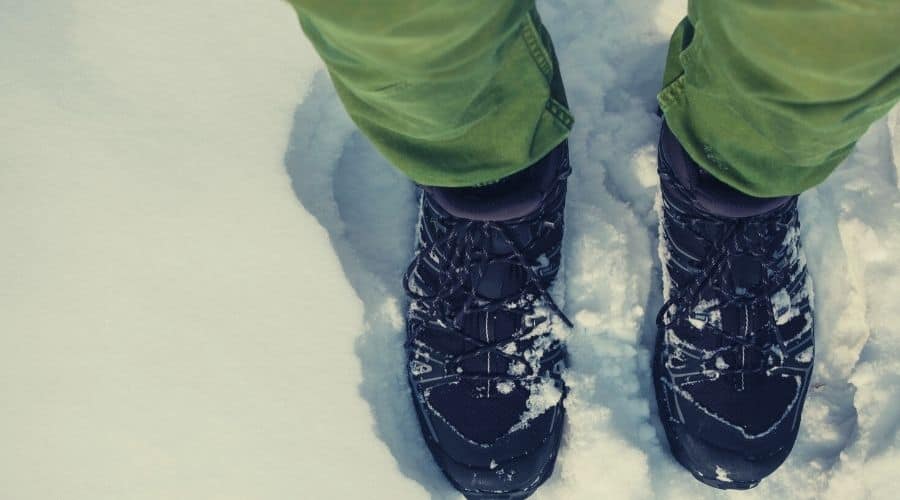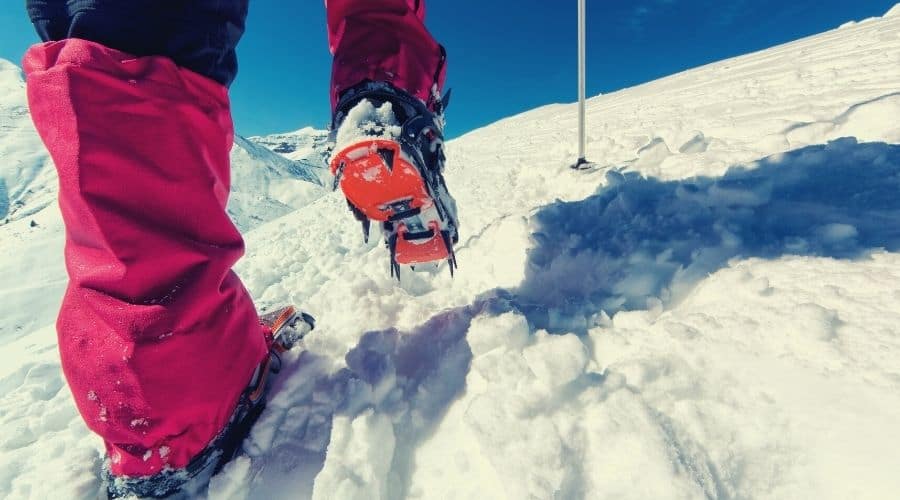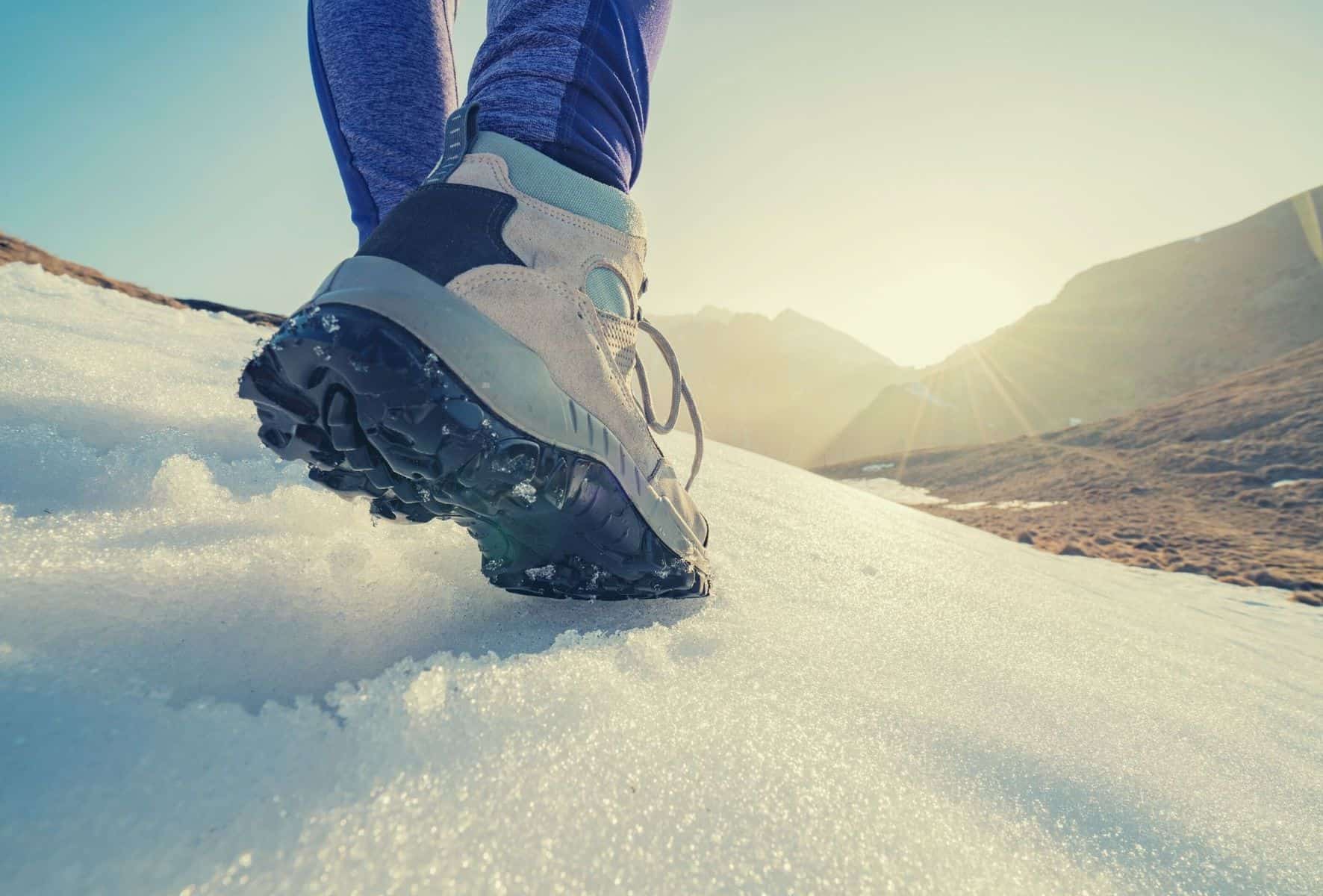Are you fed up finishing your winter hikes with frozen toes? If so, you’re not alone.
The average winter temps in popular hiking areas across the US vary significantly from location to location. But with average highs in destinations like the Grand Canyon, Yosemite, Yellowstone, Zion, Acadia (and many more) sitting around or below freezing, the potential for cold feet is always “chillingly” high.
However, avoiding frigid trotters and foot-fingers is easily done, as our short, straight-talking guide on how to keep your feet warm on a cold-weather hike will demonstrate.
Keep Your Feet Unfrozen on Winter Hikes: 9 Tips

1. Buy the Right Boots
We’ve all heard the expression “don’t bring a knife to a gunfight”. By wearing our regular, summer hiking boots on winter outings, that is, sadly, just what we’re doing.
Summer hiking boots are made to maximize breathability and prioritize weight savings over warmth. Winter boots, on the other hand, prioritize insulation and warmth.
So what does the “right” winter boot look like? While this will depend on just how cold the climate is where you do your hiking, we can make a few more general observations.
Winter boots should have a waterproof-breathable membrane (Gore-Tex or similar) that wicks interior moisture (sweat) while blocking out external moisture (rain, snow, groundwater).
They should also provide some degree of added insulation in the upper. In most cases, this takes the form of a synthetic liner and an (often removable) second tongue.
Finally, the best winter hiking boots also use beefier, insulating footbeds to prevent heat loss by way of conduction (heat lost through contact with cold surfaces) through the sole.
All of the above is exemplified by boots like the Scarpa Nepal Extreme, which has been one of the most popular boots on the market for winter hikers for decades.
2. Go a Size Up
Choose boots that are big enough to accommodate thicker insoles and thicker socks. This might mean buying a pair that is either a half or full-size larger than you usually need.
Ideally, the boots should leave a little wiggle room for your toes, even when wearing thick socks. If any tighter, you run the risk that they will limit blood flow to your feet and toes, which will result in both getting cold no matter how well the boots perform otherwise.
3. Layer Up, Even With Your Socks
The layering system principles apply to your feet just as they do to the rest of your body. If we take the boot to represent the outer “shell” layer, what we wear underneath becomes our baselayer and mid-layer.
A liner sock forms the “base layer” that shifts moisture (sweat) from our skin. If you’re feet get wet, then you’ll have cold feet, no matter whether you get wet from snow or rain, or sweat. A liner also adds to the insulation provided by our insulating “mid-layer”. This layer should take the form of a warm but breathable sock – Merino wool socks or similarly high-wicking fabric is great at keeping your feet and toes warm.
While doubling up on socks can increase the risk of blisters, if your boots fit well and you use high-wicking hiking socks, this shouldn’t be a problem.
Warning: Keeping feet warm depends on keeping feet dry. Cotton socks are the nemesis of dry and warm feet because they soak up rather than wick sweat away from the skin. The bottom line? To keep your feet warm, avoid cotton at all costs!
Extra reading: Check out our review of the best cold-weather socks to help keep your feet warm!
4. Start Warm to Stay Warm
As explained in tip #5, keeping the rest of our body warm is vital to keeping our feet warm.
Starting warm and staying warm is much easier to achieve than getting warm once on the move. This being so, always begin your hikes slightly overdressed. Taking a layer off to cool down if too hot is far more likely to achieve the desired aim than putting one on if too cold.
The same, of course, applies to your feet. While carrying a spare pair of socks is advisable, it’s always better to set off wearing warmer socks and risk having to change into a lighter pair later than vice-versa.
5. Prioritize Your Core
Keeping our core warm is crucial to keeping the rest of our body warm.
A reasonable analogy is to think of our core as the boiler in our body’s central heating system. If the center is cold, the rest of us will be too. When our core cools down excessively, it tries to consolidate heat around our major organs. In order to do so, it reduces the rate at which it pumps blood (and heat) around our body and to our extremities.
To prevent your core temperature from dropping, be sure to layer up with sufficiently warm, winter-worthy layers. This means a thicker, high-wicking baselayer, a beefy insulating mid-layer (whether fleece, down, or synthetic), and a shell layer to keep out the elements.
6. Upgrade Your Insoles
This often-overlooked component of a hiking boot can have a significant impact on your boots’ warmth.
When hiking in winter, one of the leading causes of cold feet results from “conduction”, which is the loss of heat through contact with cold surfaces. On our hikes, those “cold surfaces” take the form of frozen terrain. Given that our feet will be in contact with the ground for several hours on end, some degree of conduction is inevitable.
A thicker insole can go a long way to lessening that degree and making boots warmer. Wearing two insoles—space permitting—is all the better to keep your feet warm.

7. Wear Gaiters
Water conducts heat away from the body far quicker than air. And when that water cools down, your feet are almost dead certs to start feeling cold very quickly. Keeping your feet dry, is essential to keep your feet warm.
Even if our boots are fully waterproof, there’s a chance that moisture from snow, rainfall, puddles, or streams might sneak in around the collar or lacing. To avoid this, invest in a pair of full-length (knee-height), Gore-Tex hiking gaiters. These will provide an effective barrier to all forms of external H2O and won’t set you back much more than a 24-pack of budget beer.
8. Keep Moving
One of the quickest ways to cool down on any hike is to stop moving. In cold weather, a break of just a few minutes could be all it takes for our core temp to drop, and the shivers set in. This is particularly true if we’ve been moving fast and/or have built up a sweat.
In this case, a kind of “domino effect” occurs. When we stop moving, our warm sweat cools down quickly as our body temperature decreases. Our cooling sweat conducts more heat away from our core. When our core cools down, our extremities (hands, fingers, feet, and toes) cool down with it, usually at a much quicker rate.
To avoid cold feet, try to limit breaks to a few minutes at a time. Also, instead of moving quickly, try to walk at a slow but steady pace. By doing so, you’ll not only reduce the risk of sweating excessively, making it easier to keep your feet warm but also be able to walk for longer between breaks.
9. Know the Difference Between the Faddish and the Functional
Outdoor brands are no strangers to trying to make us part with our $ for fads and gimmicks that may be more trouble than they’re worth.
Products like vapor barrier liners and toe covers, for example, are ones we can safely throw into this category.
Vapor barrier liners are designed to keep out rainwater and groundwater found in puddles or snow. Toe covers are used mainly by cyclists to prevent windchill from numbing their toes but have recently gained some traction in the hiking world.
The bottom line with both products is that if your boots aren’t already doing what these accessories claim to do, then you have the wrong boots for winter hiking.
Those of you who’ve done your research on breathability will know these products’ lack of it will most likely result in your feet soaking with sweat in a hurry—something that’s sure to result in severe discomfort and chilly feet before long.
Some accessories more likely to prove useful are wool felt, or fleece insoles (particularly when worn in combination with regular insoles) and toe-warmers packs.
To keep your feet warm, both of these can provide a much-needed boost to temps inside your boot without limiting breathability. They’re also very cheap, so if they turn out not to be your bag, then you can discard them without too much regret as the wasted expense.
Conclusion: How to Keep Your Feet Warm When Hiking in Winter
In most parts of the world, cold-weather hiking conditions are typically not favorable to warm feet. As demonstrated in the above guide, however, there are plenty of ways to counter the cold weather’s attempts to turn our feet into frozen lumps of icy flesh.
Using these tips, we’re sure you’ll be well on your way to many much happier and more comfortable winter wanders.
So, how did you like our list?
If you have any comments or questions about cold feet when hiking, please drop them in the comments box below. And if you’d like to share it with your friends, share away!

